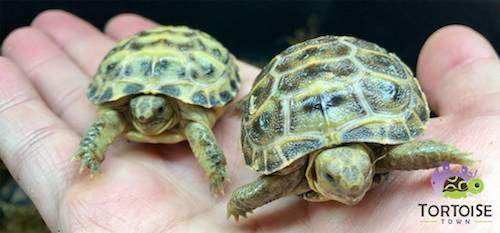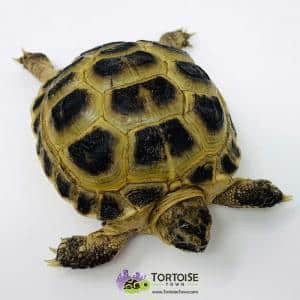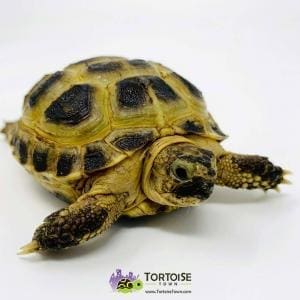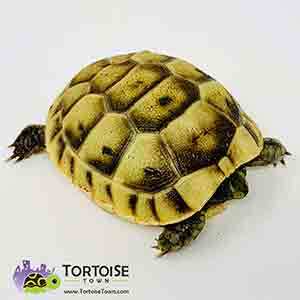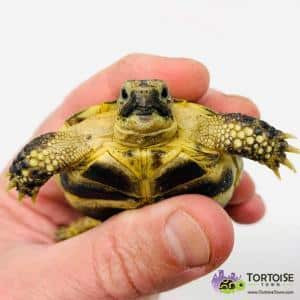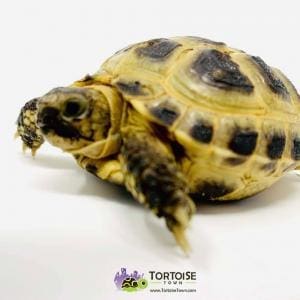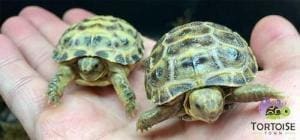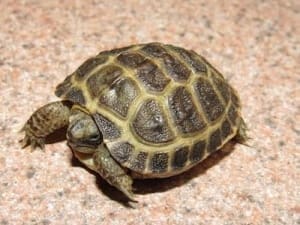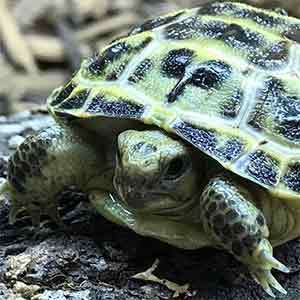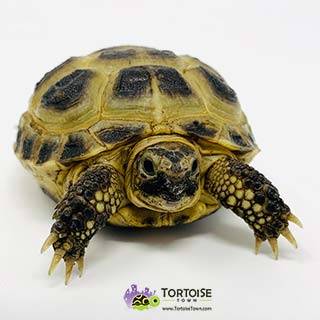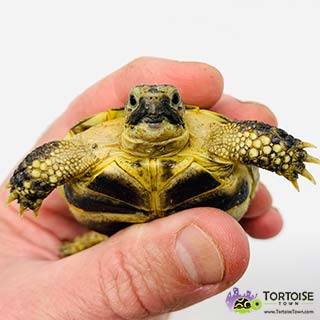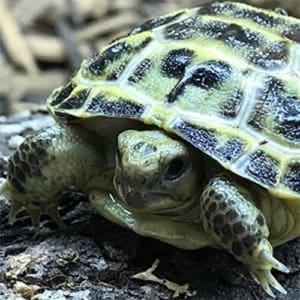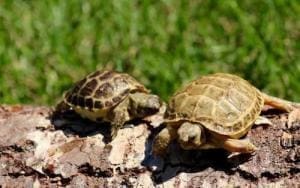Russian Tortoise Care Sheet & Russian Tortoise Care Information
Once you’ve purchased your Russian tortoise for sale, it is time to get ready to prepare for your new pet tortoise to arrive and get everything ready.
Below are some tips and information on the care of the captive bred russian tortoise. You can always email us with questions you may have about your new pet russian tortoise.
We offer a huge Russian tortoise care section of our website, all prepared by our staff Biologist. Take the time to learn proper Russian tortoise care needs including:
- Russian tortoise care sheet
- baby Russian tortoise diet
- Russian tortoise substrate
- proper Russian tortoise water
- Russian tortoise humidity
- Adult Russian tortoise size
- Russian tortoise lifespan
- baby and adult Russian tortoise habitat
- Russian tortoise UVB Lighting
- Proper Russian tortoise temperature
- Where to find the perfect Russian tortoise for sale
Russian tortoise size
Russian tortoises are one of the smaller species of tortoise for sale in the USA. These dwarf tortoises or tiny tortoises for sale make up the most popular species of the Testudo tortoise family. Russian tortoises grow from 5-10″ on average with females growing much larger than males. Baby Russian tortoise can be found from select breeders across the country, and run in the range of $225-250.00 each. Wild caught Russian tortoises should be avoided and are often found at Pet Smart and Petco. If you are looking for a Russian tortoise for sale petsmart, we recommend you NOT supporting the wild caught tortoise trade. By purchasing a captive bred baby Russian tortoise hatchling for sale, you will be supporting the captive breeding program over wild animals being taken from their natural habitat.
Russian tortoise habitat
Typically, Russian tortoise habitats for adult size animals are going to be somewhere in the neighborhood of 2′ x 4′. Also,Keep in mind that low airflow, high ambient temperature, as well as relatively High humidity are imperative for the first 12 months of life. Tortoises that are raised with low humidity will often fail before one year of age.We recommend using something that has limited airflow including an aquarium so long as you block off the side so that the animal cannot see out.
Things as simple as sweater boxes with lids can be used, paper towels of substrate, so long as you’re able to keep the ambient temperature in the neighborhood of 88°. Also, be sure to spray down your enclosure2 to 3 times a day when possible to keep the humidity where it should remain. By keeping humidity in the neighborhood of 75 to 80%, this will ensure a very smooth shell growth, as well as your Russian tortoise is not dehydrating slowly due to overhead heating elements andUVB lighting.
UVB lighting should be provided 8 to 10 hours a day in the neighborhood of a 10% UVB lamp we recommend utilizing a T5 high output lamp and fixture as opposed to a compact fluorescent screw in.
Those that are using open top enclosures need to seriously consider limiting the airflow and holding in the humidity. Sometimes, these enclosures including the tortoise house are able to be modified or supplemented by using a reptile Fokker system.We do have reptile fogger systems available here at great prices so we highly recommend that you check it out before you finish your purchase. A reptile or tortoise fogging system should be used on all baby tortoise habitats if you asked the biologists here at Tortoise Town.
Male vs Female Russian tortoise size
Did you know that female Russian tortoises for sale grow to just about double the size of males? A male Russian tortoise will grow from 5-6″ on average at full maturity. Female Russians grow anywhere from 7-10″ with a much “rounder” shape than males. Males can fight with one another and should not be kept with other male tortoises. Female Russian tortoises may be housed or kept in groups and seem to get along just fine.
Russian tortoise UVB Lighting
Providing your baby tortoise with UVB lighting is key to raising a healthy Russian tortoise hatchling for sale. UVB should be provided via a t5 HO tube style lamp. Using a 10% or 10.0 UVB lamp is fine so long as your light is around 15-20″ from the shell of the tortoise. A 12% lamp is even better however, it needs to be mounted 24″ above the tortoises and will have a great output and coverage area. We recommend using an Arcadia brand tortoise UVB light.
Baby Russian tortoise for sale – Humidity
Humidity is a big deal for any species of baby tortoise for sale, and the baby Russian tortoise is no different. Keep the humidity in the range of 65-70% for yearlings to juveniles, 50-60% for adults, and as high as 75-80% for captive bred Russian tortoise hatchlings. Using a reptile fogger will help keep the humidity up. Some people put it on the same timer as the lights, keep it filled at night. Because it is tied to the same timer, the fogger can simulate morning dew each morning when it comes on with the UVB lighting and the hot spot.
Russian tortoise Lifespan
Baby Russian tortoises live a long time! Did you know a Russian tortoise can live 50-100 years! That is correct, 100 years! That means you need to be prepared to own your tortoise for your entire life, and even maybe give it to a younger family member when you get old!
Russian tortoise diet
Feeding your new baby Russian tortoise for sale a varied diet is the best way to go. Here at the tortoise town tortoise farm, we offer a wide variety of high quality fresh greens and veggies. Using Romaine, Collard Greens, Mustard Greens, Endive, Squash, Zucchini, Bell Peppers, Kale, Shredded Carrots, the occasional tomato, we make a daily “chopped salad”. Also, to supplement more Vitamin D3 during the winter with our indoor tortoise habitats, we use Mazuri tortoise chow. Tortoise chow works best when soaked in water and softened. Some people also add their supplements right to the water so it is soaked up with the tortoise pellets.
Diet: A well-balanced Russian tortoise diet consists of:
- High fiber and calcium, low protein and fat is needed to ensure good digestive tract function.
- Dark green leafy greens like romaine, escarole, red leaf lettuce, kale, collard greens, green vegetables, limited amounts of squash, carrots, etc.
- Also benefit from a Russian tortoise commercial diet, like Mazuri tortoise chow
Russian tortoise supplements
Supplements should be provided 2-3 times weekly, like every other feeding works. We recommend using a high quality calcium with Vitamin D3, like reptocal, sold here at the tortoise store. Lastly, a vitamin supplement like Vionate can be added to the calcium powder in a ratio of 1 to 1, or 50:50.
Baby Russian tortoise for sale – Temperature
Temperature is important for both baby Russian tortoise hatchlings for sale, as well as juvenile Russian tortoise for sale and adults. A median temperature of 82 degrees during the day, with a hot spot of 90 Degrees works best. During the nighttime, temperatures may drop as low as 75 degrees for babies, or 65 degrees for adults. When temperatures drop, you will probably find, or “not be able to find” your baby Russian tortoise as they burrow under the substrate. Speaking of substrate, let’s talk about it!
Baby Russian tortoise care – Substrate
Substrate can be anything that has no additives or pesticides or fertilizers. Using a substrate like organic potting mix works great when mixed with forest floor, sold here. Forest floor is a cypress mulch and absorbs odor and works quite well. Providing a potting or soil mix of 2-4″ of depth also will help your tortoise dig down properly and thermoregulate.
Captive bred Russian tortoise for sale
Be Careful! Most Russian tortoises are imported into the United States. In contrast to the number of imported tortoises, captive bred Russian tortoise availability is relatively low. However, here at tortoise town, we produce around 150 baby Russian tortoise for sale each season. Therefore, you should assume that most adult or subadult Russian tortoises for sale are wild-caught (imported). Captive-bred babies are rarely raised to adult size and sold at low prices. Because wild-caught tortoises are imported for very low prices, they are sold cheaper at pet stores. Captive bred babies will always be 2-3 times the price that these imported Russian tortoises sell for. So if you see Russian torts under $200.00 you can almost guarantee they are older, wild caught specimens and should be avoided at all costs.
We offer various ages/sizes for sale available thru the drop-down shopping cart options. Therefore offer various sixes of Russian tortoise hatchlings for sale. Our sizes include well-started baby Russian tortoises for sale (recommended over hatchlings). Also, we offer yearlings and juvenile Russian tortoises.
Feeding your Russian Tortoise
Things to remember when feeding your Russian tortoise:
- Fresh, clean, chlorine free water should be available at all times. Daily soaks for 20 minutes in luke warm shallow water are recommended for all baby tortoises and tortoise under 18 months of age. Some tortoises have a tendency to go to the bathroom in their water bowl, so expect to clean and disinfect this daily, if you soak them separately each morning, this reduces the frequency of them dirtying their own water dishes.
- Feed tortoises daily; finely chop vegetables.
- Sprinkle food with calcium supplement once or twice a week once tortoise is 6 months of age.
- Discard food not eaten within 24 hours.
Explore our entire Russian tortoise care section
- Housing your pet Russian tortoise
- Size – Indoor enclosure should be at least 36”x18”; outdoor enclosure should be at least 48”x48” with a secure screened cover to allow sunshine but provide protection; the walls should be high enough that the tortoise can’t escape and buried at least 12” into the ground, as Russian tortoises will dig but not too much.
- Russian tortoise habitat – Keep habitat arid and dry, with shaded areas to escape direct sunlight. Humid climates may need a dehumidifier, and cool climates require supplemental heating. Provide a hiding area, such as a cave or hide box filled with additional substrate. Maintain less than 60% humidity.
- Substrate – Tortoises are known for eating substrate, so use something that is digestible such as alfalfa pellets; substrate should be deep enough for the tortoise to burrow. Don’t use coarse substrates such as sand or gravel that can scratch the shell.
- Temperature – Temperature gradient (85°F for the warm end and 75°F for the cool end); recommend using an incandescent light or ceramic heater as primary heat source.
- Lighting – Providing UVB lighting for 12 to 14 hours a day is required.
- Water – Provide constant access to a shallow container large enough for the tortoise to soak in and drink from; the tortoise should be able to easily enter and exit the water bowl.
- Russian tortoises can be kept together and enjoy other tortoises company.
Normal Russian Tortoise Behavior
- Active, friendly and outgoing.
- Will become tame with gentle handling and time; move slowly around tortoises to avoid startling them.
- Adept at digging to escape; hide in objects and burrow into the substrate.
Habitat Maintenance
Thoroughly clean and disinfect the habitat at least once a week: place tortoise in a secure habitat; scrub the tank and furnishings with a 3% bleach solution; rinse thoroughly with water, removing all traces of bleach smell; dry the tank and furnishings completely and add clean substrate.
Grooming & Hygiene
Weekly water soaks with water level no deeper than the mid-point between the bottom of the tortoise’s shell and its top.
Health
Signs of a Healthy Pet Russian Tortoise
- Active and alert
- Eats regularly
- Healthy shell
- Clear, bright eyes
- Healthy skin
- Clear nose and vent
Signs of a possibly sick baby or adult Russian tortoise
- Eye, nose or mouth discharge
- Soft, discolored or rough spots on shell
- Lethargic
- Bumps or spots on skin
- Abnormal feces
- Sneezing, mouth breathing or runny nose
- Overgrown beak
If you notice any of these signs, contact your veterinarian.
It is very important you find the right russian tortoise breeder that only works with captive bred baby tortoises for sale, NOT wild caught. The biggest problem with russian tortoises for sale is that most are wild caught and can be as old as 40-50 years old when you buy the russian tortoise. So when you see a very cheap russian tortoise price, you know it is NOT a captive bred russian tortoise.

